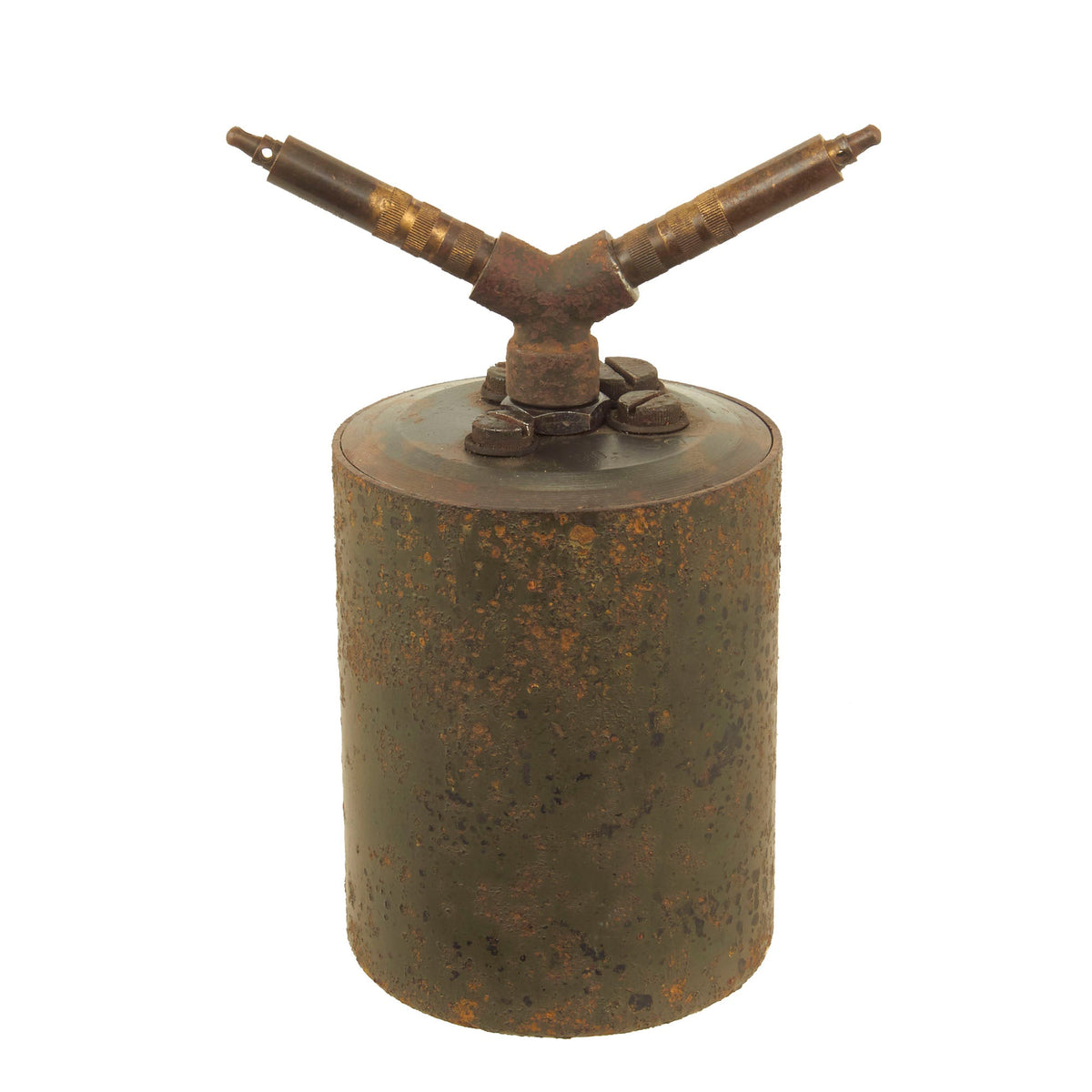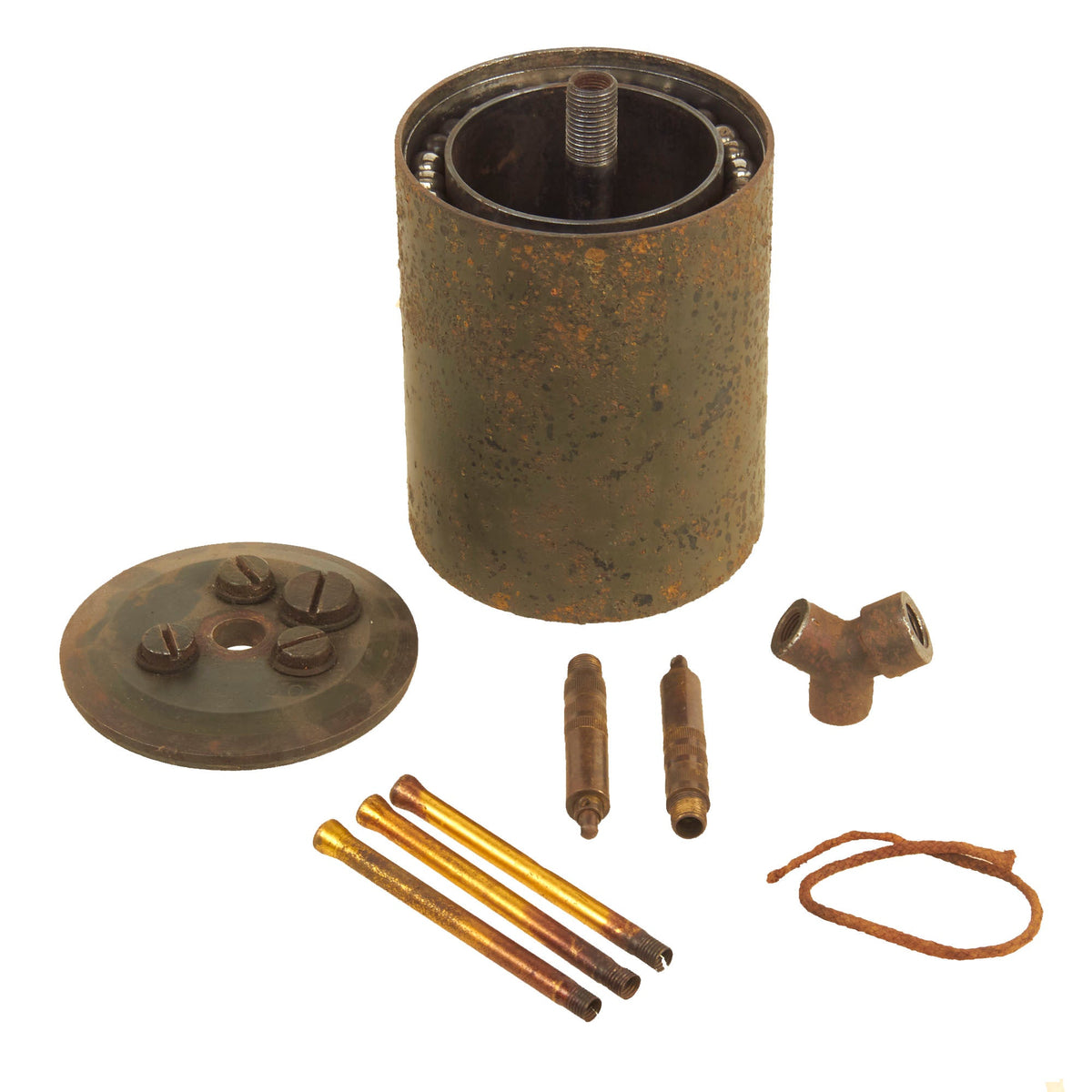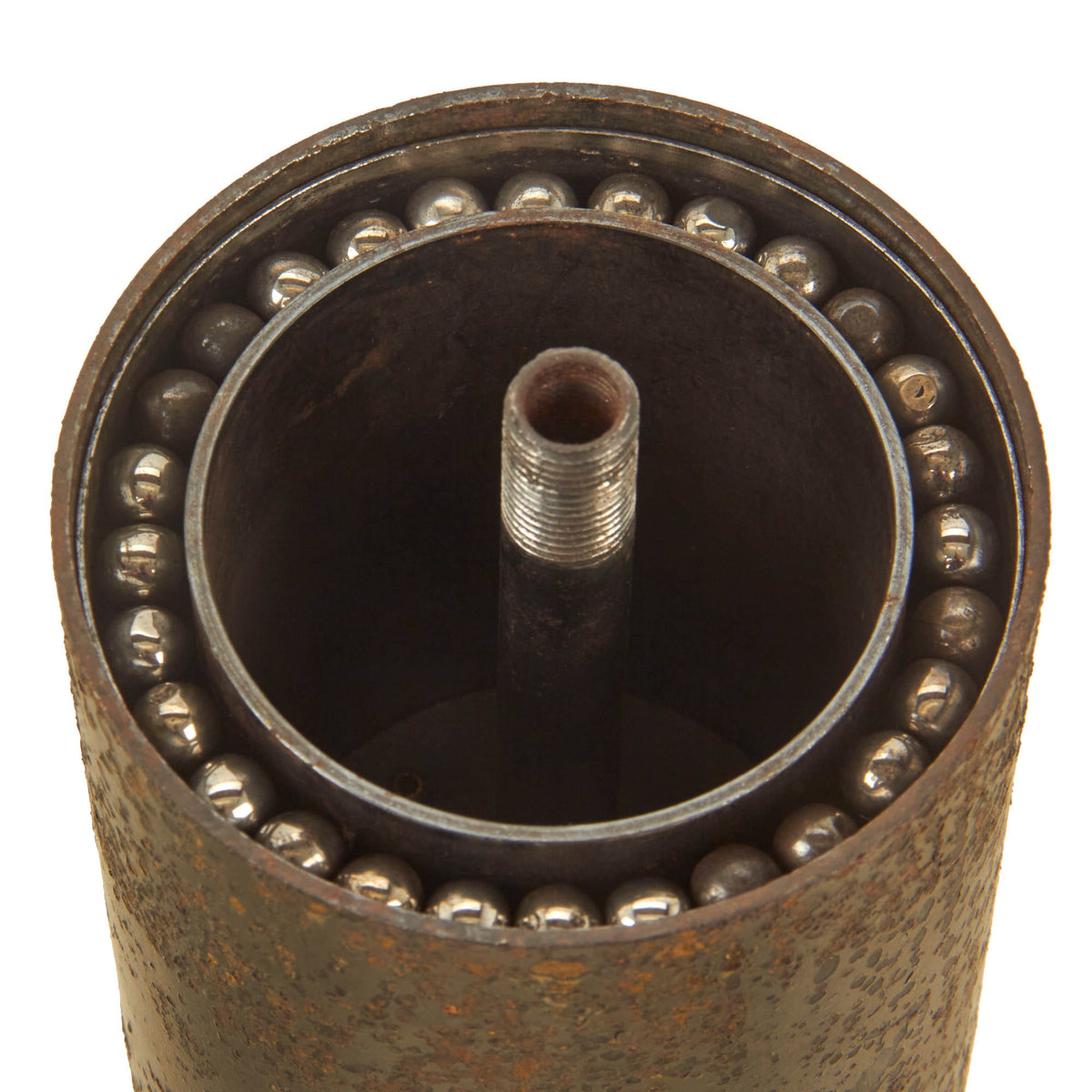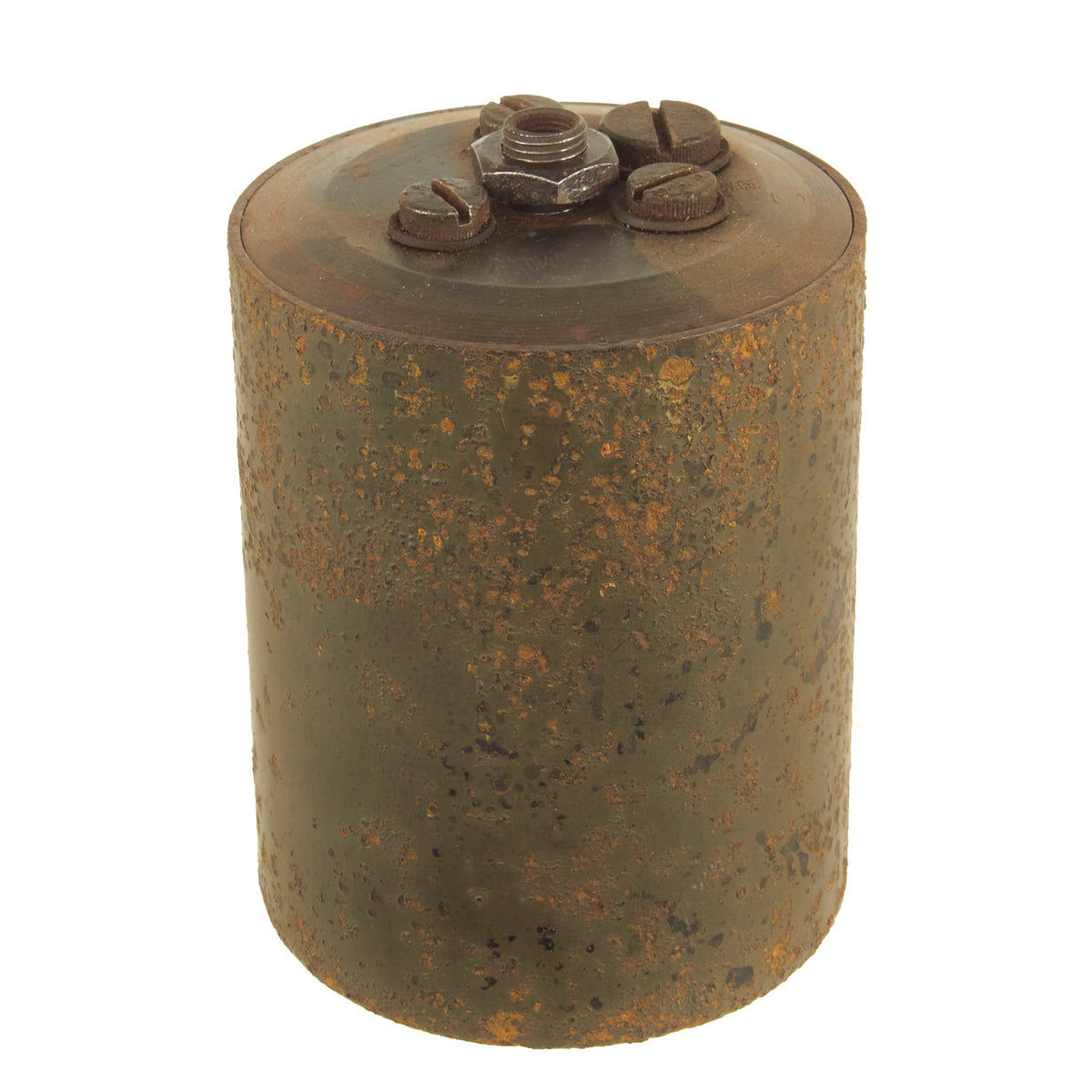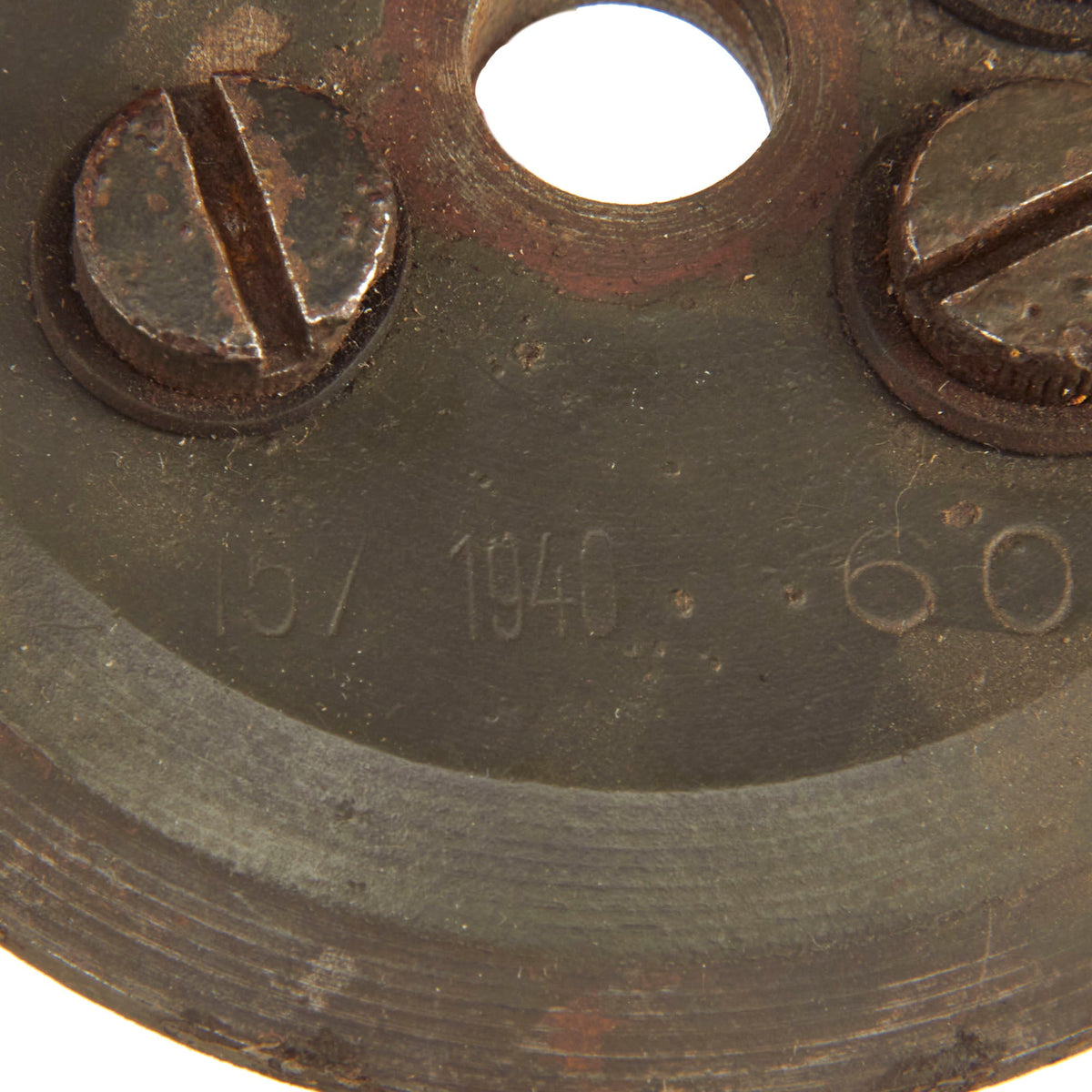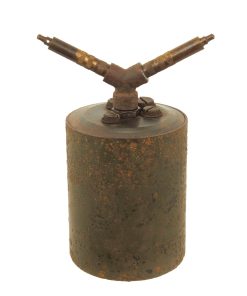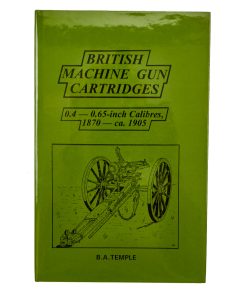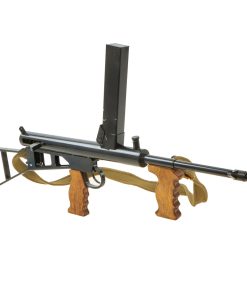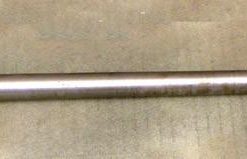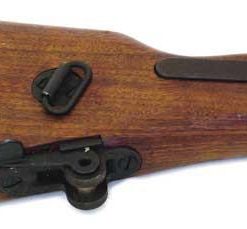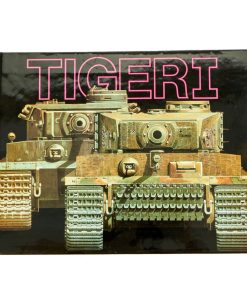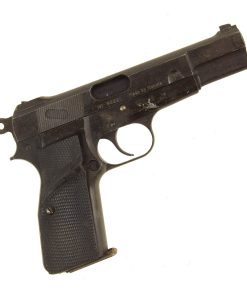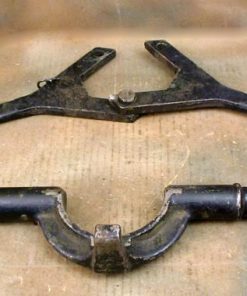Original German WWII Inert 1940 dated Bouncing Betty S-Mine by Fritz Weber & Co. Metallwaren und Laternenfabrik, Berlin with Shrapnel Original Items
$ 750,00 $ 225,00
Original Item: Only One Available. This is an Incredible totally inert original German WWII 1940 dated S-Mine, with two tripwire activated fuses as well other accessories including the hard to find fuse elbow. The interior is filled with replica shrapnel (used ball bearings) which are nearly identical to the shrapnel that would have been used during WWII. These give weight and authenticity to the mine.
NOT AVAILABLE FOR EXPORT
The mine bears original green paint on the exterior, it is maker marked on the top with F. W. Co. and dated 1940. This is the marking for Fritz Weber & Co. Metallwaren- und Laternenfabrik, Berlin. The company was founded by Fritz Weber, who had a key position as an economic leader within the Wehrkreis (army district). He was also a member of the NSDAP. Between 1935 and 1940 he built a new factory complex at the corner of Kiefholz- and Lohmühlenstraße in Berlin. The factory made equipment for the Wehrmacht. Among the products were MG34 ammo cans, barrel carriers and other ammunition containers. The company employed 2,300 persons in the prewar years. These were gradually replaced by “Ostarbeiter”, workers imported from the occupied territories. The factory complex was damaged by US bombers on 21. June 1944 and again on 3. February 1945. The frontline reached the factory complex with street fights 26. April 1945, and all production stopped.
Overall a nice example of an extremely rare S-mine. These are banned from import to the USA (and export) so only examples that came back with WWII veterans after the war are available, making these incredibly difficult to find on the collector’s market.
The German S-mine (Schrapnellmine, Springmine or Splittermine in German), also known as the “Bouncing Betty”, is the best-known version of a class of mines known as bounding mines. When triggered, these mines launch into the air and then detonate at about 0.9 meters (3 ft). The explosion projects a lethal spray of shrapnel in all directions. The S-mine was an anti-personnel mine developed by Germany in the 1930s and used extensively by German forces during World War II. It was designed to be used in open areas against unshielded infantry. Two versions were produced, designated by the year of their first production: the SMi-35 and SMi-44. There are only minor differences between the two models.
The S-mine entered production in 1935 and served as a key part of the defensive strategy of the Third Reich. Until production ceased in 1945, Germany produced over 1.93 million S-mines. These mines inflicted heavy casualties and slowed, or even repelled, drives into German-held territory throughout the war. The design was lethal, successful and much imitated. The S-mine remains one of the definitive weapons of World War II.
French soldiers encountered the S-mine during minor probes into the coal-rich German Saar region in September 7–11, 1939, during the Saar Offensive. The S-mine contributed to the withdrawal of these French incursions. The mine’s performance in the Saar region affirmed its effectiveness in the eyes of the German leadership and prompted the United States and other countries to copy its design. After their experience, the French nicknamed the mine “the silent soldier”.
The Third Reich used the S-mine heavily during the defense of its occupied territories and the German homeland during the Allied invasions of Europe and North Africa. The mines were produced in large numbers and planted liberally by defending German units. For example, the German Tenth Army deployed over 23,000 of them as part of their defense preparation during the Allied invasion of Italy.
S-mines were deployed on the beaches of Normandy in preparation for the anticipated invasion as part of a general program of heavy mining and fortification. On the Îles-St.-Marcouf, just off Utah Beach, where the Allied planners feared the Germans had established heavy gun batteries, Rommel had ordered S-mines to be “sown like grass seed.” To build the Atlantic Wall, Germans deployed millions of mines of various types, anti-personnel mines (such as the S-mine), dug hundreds of kilometers of trenches, laid barbed wire, and constructed thousands of beach obstacles. The mines were subsequently used to defend German positions during the Battle of Normandy and in the defense of Northern France and the German border. S-mines were typically used in combination with anti-tank mines to resist the advances of both armor and infantry. The Allies removed an estimated 15,000 unexploded mines from dunes by Pouppeville after the initial invasion.
The S-mine acquired its cynical nickname “Bouncing Betty” from American infantrymen. The S-mine had a great psychological effect on Allied forces because of its tendency to maim, rather than kill, the infantryman. The German habit of laying the mines around anti-tank and anti-vehicle mines contributed to the reputation. If a vehicle was disabled by a mine, the soldiers would be trapped in it until someone came to rescue them. In particular, limbs and genitalia were the most vulnerable. In his book Mine Warfare on Land, Lt. Col. Sloan described the S-mine as “probably the most feared device encountered by Allied troops in the war.” Exact death tolls inflicted by the S-mine are not known. The Allies did not record whether a death was caused by a particular type of weapon, only whether or not the death occurred in the course of battle. Regardless, some unofficial assessments credit the S-mine with having caused significant casualties. The 4th Division 12th Regiment at Utah Beach suffered what it termed as “light” casualties in the landing, most of which were caused by S-mines. Civilian casualties are even more a matter of speculation.
S-mine production ceased after the end of World War II. No information has been discovered as to the exact fate of the remaining stockpiles of the S-mine, but it can be assumed a majority were destroyed as part of the disarmament of Germany after its surrender, although possibly some were preserved for study and reverse engineering by the Allies. Many direct imitations of the S-mine appeared in the years following World War II.
During the military occupation of Germany and the postwar rebuilding of Europe, the American Army Corps of Engineers, the newly established French government, and the British Ministry of Defence engaged in one of the most prolonged and successful mine-clearing operations throughout Western Europe. France deployed a variety of personnel to undertake this task, including 49,000 German prisoners of war. This joint operation eliminated a majority of the remaining fields of mines on the war-torn western half of the continent and was greatly assisted by the German policy of clearly marking and accurately recording the locations of minefields.
However, incidents involving accidental explosions of mines in North Africa, the former Warsaw Pact countries, France, and Germany still occur sporadically. North Africa and Eastern Europe have a particularly large amount of uncleared World War II-era minefields, lost in the desert sands or forgotten by authorities. In Libya, for example, the Red Cross estimates that over 27% of farmland is unusable due to World War II minefields. While German documentation says the S-mine had an effective lifespan of two to seven years once planted, the explosive charge could still operate in mines to this day.
The German S-mine was a steel cylinder approximately 15 centimeters (5.9 in) tall without its sensor and around 10 centimeters (4 in) in diameter. A steel rod protruding from the mine’s top held the main fuse, where its trigger or sensor was attached. The SMi-35 had a central fuse, while the SMi-44 had an offset fuse. It weighed approximately 4 kilograms (8.8 lb), with the weight depending on whether it was loaded with the lighter powdered or the heavier poured TNT.
The main charge of the mine used TNT as its explosive; the propelling charge was black powder. The standard pressure sensor used a percussion cap to ignite it.
The main fuse was designed to delay the firing of the propelling charge for approximately four seconds after the mine was triggered. The explosion of the propelling charge sent the mine upwards into the air and activated three short-delay pellets between the propellant charge and the three detonators. These short-delay pellets delayed the mine’s detonation long enough for it to reach an appropriate height before exploding.
The standard pressure sensor was designed to activate if depressed by a weight of roughly 7 kilograms (15 lb) or greater. This ensured the mine was not detonated by wildlife or natural impact of blowing leaves, branches, or other normally occurring phenomena
The S-mine was normally triggered by a three-pronged pressure fuse. It could also be modified to be triggered by a tripwire. A special tripwire adapter was provided by the German army. The steel tube that held the fuse was threaded to accept any standard German ignition or trigger, allowing the sensor to be removed and the mine to be deliberately triggered by a human operator. When triggered, the mine functioned in two stages.
1) First, the mine was fired 0.9 to 1.5 meters (3 to 5 ft) upwards by a small propellant charge.
2) Approximately a half-second later, the main charge detonated at the optimum height to kill or severely injure anyone in the immediate area.
3) The main charge of the mine was surrounded by roughly 360 steel balls, short steel rods, or scrap metal pieces. These became metal shrapnel that sprayed horizontally from the mine at high velocity.
The time between triggering and ignition of the propelling charge varied between 3.9 and 4.5 seconds, depending on the age and condition of the mine. According to German documentation, the S-mine was lethal within 20 meters (66 ft) and could inflict casualties within 100 meters (330 ft). American training manuals warned of casualties at up to 140 meters (460 ft).
A common misconception prevailed that the S-mine would not detonate until its victim stepped off the trigger. This fallacy was propagated by incorrect United States propaganda during World War II. The mine would detonate whether the trigger was released or not. Standing still or attempting to run from the S-mine would be equally dangerous. The most effective way to survive the mine’s detonation would not be to flee but to fall to the ground lying face down as quickly as possible.
S-mine dischargers, in the form of angled tubes attached via brackets to the hull, were also used for anti-infantry defense by Wehrmacht armored vehicles. Early versions of the Tiger I were equipped with five such devices.
Fast Shipping with Professional Packaging
Thanks to our longstanding association with UPS FedEx DHL, and other major international carriers, we are able to provide a range of shipping options. Our warehouse staff is expertly trained and will wrap your products according to our exact and precise specifications. Prior to shipping, your goods will be thoroughly examined and securely secured. We ship to thousands clients each day across multiple countries. This shows how we're dedicated to be the largest retailer on the internet. Warehouses and distribution centres can be located throughout Europe as well as the USA.
Note: Orders with more than one item will be assigned a processing date depending on the item.
Before shipping before shipping, we'll conduct a thorough inspection of the items you have ordered. Today, the majority of orders will be delivered within 48 hours. The delivery time will be between 3-7 days.
Returns
The stock is dynamic and we cannot completely manage it because multiple stakeholders are involved, including our factory and warehouse. So the actual stock may alter at any time. It's possible that you may not receive your order once the order has been made.
Our policy is valid for a period of 30 days. If you don't receive the product within 30 days, we are not able to issue a refund or an exchange.
You can only return an item if it is unused and in the same state as the day you received it. You must have the item in its original packaging.
Related products
Uncategorized
Uncategorized
Uncategorized
Uncategorized
Uncategorized
Australian WWII Owen MK1 Machine Carbine SMG Custom Fabricated Replica with Sling Original Items
Uncategorized
Uncategorized
Uncategorized
Uncategorized
Uncategorized
Australian WWII Owen MK1 Machine Carbine SMG Custom Fabricated Replica with Sling Original Items
Uncategorized
Uncategorized
Uncategorized
Uncategorized
